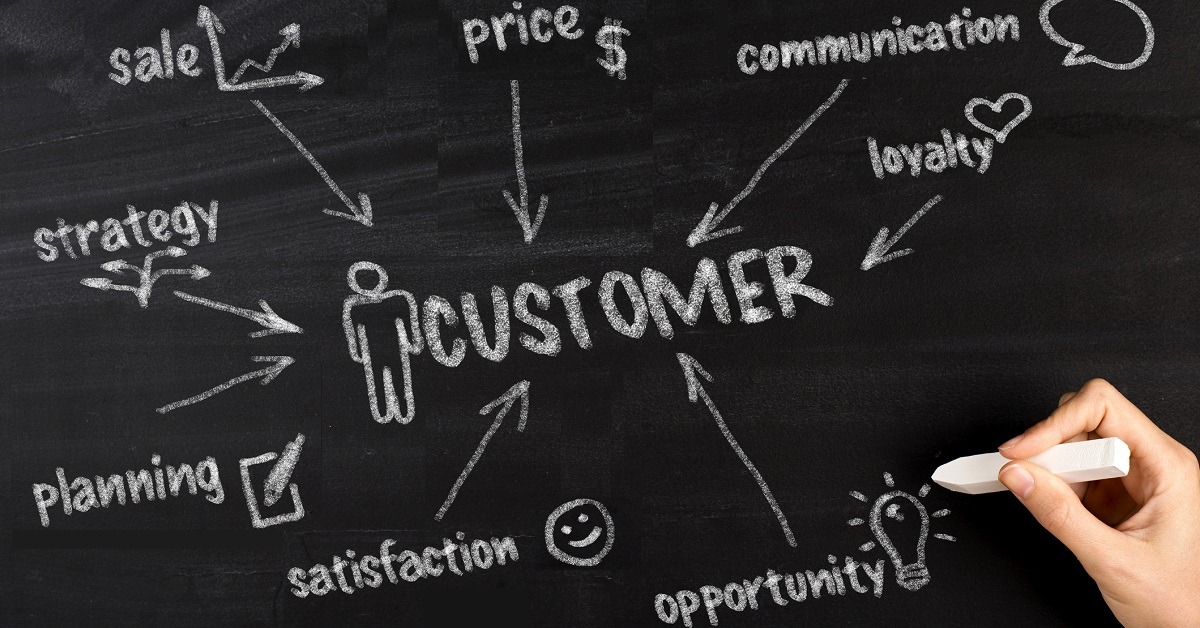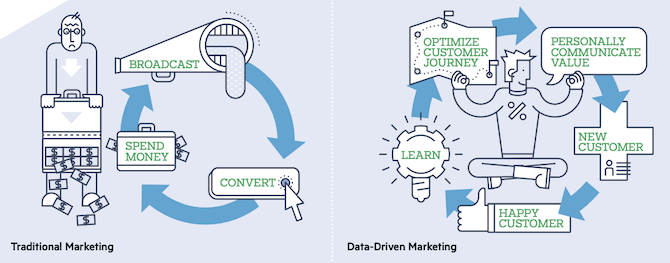How to Use the Customer Lifetime Value Metric to Improve Your Digital Experiences

Learn how you can use the Customer Lifetime Value metric to improve your digital experiences, make customers happier and increase your profitability.
Customer lifetime value sounds like one of those meaningless buzzwords that people throw around to try and convince businesses to spend more money. But the fact of the matter is, customer lifetime value (CLV) is the most important metric to track in business. And that’s especially true when it comes to your digital experiences.
Essentially, the CLV tells us how much each customer is worth. The basic premise goes like this: The longer someone does business with you, the more loyal they become and the more money they’ll spend. The briefer and more infrequent their interactions, the less money they’ll spend over time.
You might not think this matters. After all, your sales and marketing strategy will take care of bringing in a steady stream of new users to the website or app. But that’s actually a bad move.
There’s an old statistic that’s been flying around for about a decade, but it’s still as relevant today as it was then:
It costs seven times more to acquire a new customer than it does to retain one.
The Sitefinity Data-Driven Marketing report does a great job depicting the difference between customer acquisition and customer retention:

What you see here is how costly and time-consuming traditional marketing to new customers can be when compared to the more efficient data-driven marketing approach taken to keep existing customers happy and loyal.
In other words, you need a stronger customer retention strategy for your digital experiences if your digital solution is going to be profitable and viable over the long run. And your data is the key to fleshing that out.
How Do You Figure Out Your Customer Lifetime Value?
Let’s be honest: It’s not easy to get consumers’ attention today. There are just too many distractions that get in the way, not to mention the issue of information overload. And there’s also the matter of waning consumer loyalty.
Of course, it’s going to be difficult to get and then keep a website visitor’s or app user’s attention when you’re contending with that. But it’s exactly what you need to do.
By studying your metrics (starting with the CLV), you can design better digital experiences, starting with your app or website, and then moving to search, email, social media, and anywhere else they’re bound to interact with you. The better their experience, the greater the chance you’ll retain their attention and business for a long time to come.
So, let’s start by calculating the CLV.
Before we do, please make a copy of this table and use it to calculate your own CLV:
|
Sample Month |
|
|
Revenue |
|
|
Unique Customers |
|
|
Average Monthly Customer Value |
|
|
Average Lifespan |
|
|
Customer Lifetime Value |
|
If your website or app is brand new, give it at least one year before you calculate this statistic. You need to give it time to build up enough traffic and engagement for this metric to be meaningful.
For the rest of you, choose a month when traffic and usage was relatively steady over the past year and was also reflective of the average engagement your digital solution receives.
Then, you can use your financial reports to do the following: Find the gross earnings (before taxes and fees) your website or app generated during that time period. Sum up the number of unique customers you had during that time frame (i.e. don’t count anyone who converted on numerous occasions). Divide the money earned by the number of customers to figure out the average monthly customer value. Calculate how long customers buy from you on average (in terms of total months). Multiply the average monthly customer value by the total number of months you typically retain a customer to get your CLV.
|
Sample Month |
June ‘20 |
|
Revenue |
$10,000 |
|
Unique Customers |
100 |
|
Average Monthly Customer Value |
$100 |
|
Average Lifespan |
24 |
|
Customer Lifetime Value |
$2,400 |
This example shows you how much money your business would stand to earn from each customer it retains on its website or app for two years.
Let’s knock that number down to a year and see how the CLV changes:
|
Sample Month |
June ‘20 |
|
Revenue |
$10,000 |
|
Unique Customers |
100 |
|
Average Monthly Customer Value |
$100 |
|
Average Lifespan |
12 |
|
Customer Lifetime Value |
$1,200 |
That cuts each customer’s value in half. So, we can see that the length of the relationship you have with customers is very important.
Something similar happens when your customers spend less money with you. Here’s what that would look like with the original data in place, save for the total monthly revenue:
|
Sample Month |
June ‘20 |
|
Revenue |
$7,500 |
|
Unique Customers |
100 |
|
Average Monthly Customer Value |
$75 |
|
Average Lifespan |
24 |
|
Customer Lifetime Value |
$1,800 |
You can see that there are a number of factors that affect the CLV. In this case, it’s the average spend per customer.
If your digital experience isn’t set up to capture as much revenue or loyalty from your customers as it has the potential to, you could be losing quite a bit of money.
But that’s not the only metric you should be concerned with...
Why Does the CAC Matter?
When you look at the numbers above, you might be thinking that they don’t look too bad. But the CLV doesn’t tell you the full story.
Sure, if all goes as planned and you end up with the most positive outcome, $2,400 earned from every customer isn’t too shabby. However, that’s not really what you’re pocketing at the end of the day.
Remember how I talked about the differences between the cost of customer acquisition and retention before? That’s where this comes into play.
What we need to do now is calculate your customer acquisition costs (CAC).
Calculate the CAC
Customer acquisition costs are the ones your business accrues in order to bring new customers into the business.
Let’s add the numbers to a new table:
|
Average Marketing Costs |
|
|
Average Sales Expenses |
|
|
Average Digital Costs |
|
|
Total Monthly Costs |
|
|
New Customers Acquired |
|
|
Average Monthly Acquisition Cost |
|
|
Average Lifespan |
|
|
Customer Acquisition Cost |
|
|
Customer Lifetime Value |
|
|
True Customer Lifetime Value |
|
Just as we did with the CLV, you’ll want to pull data from the same representative month so we can get an accurate idea of how much it actually costs to acquire customers.
Then, you can run through the formula:
- Total up your inbound and outbound marketing costs (e.g. content marketing, social media campaigns, Google ads, marketing staff salaries)
- Total up all money spent on sales (e.g. sales team salaries, sales funnel software, live chat systems, product demos)
- Total up the money spent to manage and maintain your digital solution (e.g. hosting, app store listing, premium themes and templates, security or performance add-ons, taxes and fees)
- Total up the three sources of costs
- Calculate how many new customers you acquired during that time period
- Divide your total costs by the number of customers to get the average monthly acquisition cost
- Enter the Average Lifespan metric from earlier into the table and multiply it by the average monthly acquisition cost to get your CAC
- Enter the CLV metric from earlier into the table. Then, subtract the CAC from it to get the True Customer Acquisition Cost
Here’s what that might look like:
|
Average Marketing Costs |
$2,000 |
|
Average Sales Expenses |
$1,500 |
|
Average Digital Costs |
$300 |
|
Total Monthly Costs |
$3,800 |
|
New Customers Acquired |
75 |
|
Average Monthly Acquisition Cost |
$51 |
|
Average Lifespan |
24 |
|
Customer Acquisition Cost |
$1,224 |
|
Customer Lifetime Value |
$2,400 |
|
True Customer Lifetime Value |
$1,176 |
That’s kind of disheartening, isn’t it? You really only get to keep about half of your earnings after expenses have come out. Like I said before, it’s really expensive to acquire new customers.
Calculate the CRC
The customer retention cost isn’t something that many businesses bother calculating, but it’s an important one to be aware of. It’s the only way to truly understand the ramifications of prioritizing your customer acquisition strategy over customer retention.
Here’s the table you can run the formula through:
|
Average Marketing Costs |
|
|
Average Sales Expenses |
|
|
Average Digital Costs |
|
|
Total Monthly Costs |
|
|
Customers Retained |
|
|
Average Monthly Retention Cost |
|
|
Average Lifespan |
|
|
Customer Retention Cost |
|
|
Customer Lifetime Value |
|
|
True Customer Lifetime Value |
|
The formula is nearly identical to the CAC, but it focuses on customers retained. So, it goes like this:
- Total up your inbound marketing and loyalty costs (e.g. email marketing management, social media engagement, rewards/loyalty program management).
- Total up all money spent on sales (e.g. email up-sells, customer follow-up calls, abandoned cart recovery software/automations).
- Total up the money spent to manage and maintain your digital solution (e.g. hosting, app store listing, premium themes and templates, security or performance add-ons, taxes and fees).
- Total up the three sources of costs.
- Calculate how many customers you retained during that time period.
- Divide your total costs by the number of customers to get the average monthly retention cost.
- Enter the Average Lifespan metric from earlier into the table and multiply it by the average monthly retention cost to get your CRC.
While you still have to spend money on marketing and sales, it shouldn’t be anywhere near as much as with your customer acquisition campaigns. So, let’s assume that the statistic about acquisition costs being seven times what retention costs are. Here’s how your numbers would stack up:
|
Average Marketing Costs |
$285 |
|
Average Sales Expenses |
$214 |
|
Average Digital Costs |
$300 |
|
Total Monthly Costs |
$799 |
|
Customers Retained |
75 |
|
Average Monthly Retention Cost |
$16 |
|
Average Lifespan |
24 |
|
Customer Retention Cost |
$384 |
|
Customer Lifetime Value |
$2,400 |
|
True Customer Lifetime Value |
$2,016 |
That’s $2,016 earned when you focus on retaining customers as opposed to $1,176 when acquiring new customers.
Obviously, the formula isn’t as simple as that as you still want to be acquiring customers while retaining existing ones. But you get the idea. You want your overall acquisition/retention costs to stay as low as possible so that your profit margins can soar.
What Should You Do Now?
One thing you could do is make your marketing campaigns and sales strategies more effective, so you can get more customers without having to spend any more money. But you and I know that’s easier said than done.
Your best bet, then, is to invest more time and money into your existing customer relationships. This would involve repairing the digital experiences they interact with along the way. If you have a leaky funnel in your app or website, now is the time to repair it.
By removing friction, creating extra value, and giving customers more reasons to re-engage, you can effectively manipulate your CLV in your favor. And that’s key.
It’s not just about the digital experience. Yes, you have to impress leads and customers alike with the on-site or in-app experience straight out the gate.
This needs to be an ongoing process, which the Progress Sitefinity team has so kindly demonstrated here:

Bottom line: If you’re not using your data to deliver an ongoing supply of benefits, rewards, and reasons to return, it will eventually cut into your lifetime profits and the overall viability of your digital solution.

Suzanne Scacca
A former project manager and web design agency manager, Suzanne Scacca now writes about the changing landscape of design, development and software.
